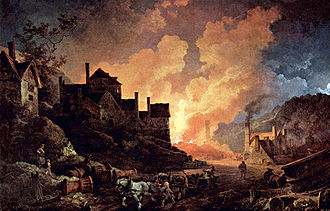
Madeley Wood Company
Encyclopedia
The Madeley Wood Company was formed in 1756 when the Madley Wood Furnaces, also called Bedlam Furnaces, were built beside the River Severn
, one mile west of Blists Hill.
 The Bedlam Furnaces were owned by this company, which held mineral leases in Madeley
The Bedlam Furnaces were owned by this company, which held mineral leases in Madeley
Parish, enabling it to extract coal and iron ore. The works were taken over by Abraham Darby III
of the Coalbrookdale
Company in 1776. When the company was reorganised in 1797, the Madley Wood Works became separate from Coalbrookdale, continuing (in conjunction with the Ketley
ironworks) in the hands of the Reynolds family who had been partners at Coalbrookdale since the 1760s. After Joseph Reynolds decided to concentrate on his bank, the Madeley Wood Works passed to the Anstice family, one of whom had managed it, and their business became another Madley Wood Company.
Upon its opening in 1790, the ironworks had access to the Shropshire Canal
, the Blists Hill section of which ran immediately to the east of the Blists Hill works site. Proximity of raw materials and the means of transporting the finished product persuaded the company to build a blast furnace
at Blists Hill in 1832.
Additional furnaces were added in 1840 and 1844, making a total of three, and the site remained active in the production of pig iron until 1912 when the ironworks ceased production, following the blowing in of two of the furnaces.
The name Bedlam Furnaces may have originated with a painting by John Sell Cotman
(1782–1842) who painted the furnace in 1803 and titled it Bedlam Furnace Near Irongate, Shropshire. He was on tour with a fellow less well known artist called Paul Sandby Munn (1773–1845) who also pained the same subject with and titled it Bedlam Furnace, Madeley Dale, Shropshire. It was both a metaphor (the place appeared to the painters to resemble a lunatic asylum), and simultaneously a jest at the expense of Fletcher of Madeley (1729–1785) a then famous Methodist preacher in whose parish the ironworks were located.
The site history through the 20th century is less well documented. Dense vegetation cover was allowed to establish itself amongst the ruins until the late 1950s when the site was subject to spoil dumping, which completely buried the furnace bases. In the 1970s what was to become the Ironbridge Gorge Museum Trust
began clearing and restoring the works.
River Severn
The River Severn is the longest river in Great Britain, at about , but the second longest on the British Isles, behind the River Shannon. It rises at an altitude of on Plynlimon, Ceredigion near Llanidloes, Powys, in the Cambrian Mountains of mid Wales...
, one mile west of Blists Hill.

Madeley, Shropshire
Madeley is a town and civil parish in Shropshire, England, now part of the new town of Telford. The parish had a population of 17,935 at the 2001 census.Madeley is recorded in the Domesday Book, having been founded before the 8th century...
Parish, enabling it to extract coal and iron ore. The works were taken over by Abraham Darby III
Abraham Darby III
Abraham Darby III was an English ironmaster and Quaker. He was the third Abraham Darby in three generations of an English Quaker family that played a role in the Industrial Revolution....
of the Coalbrookdale
Coalbrookdale
Coalbrookdale is a village in the Ironbridge Gorge in Shropshire, England, containing a settlement of great significance in the history of iron ore smelting. This is where iron ore was first smelted by Abraham Darby using easily mined "coking coal". The coal was drawn from drift mines in the sides...
Company in 1776. When the company was reorganised in 1797, the Madley Wood Works became separate from Coalbrookdale, continuing (in conjunction with the Ketley
Ketley
Ketley is a suburb of the new town of Telford in the borough of Telford and Wrekin and ceremonial county of Shropshire, England. It is a civil parish. East Ketley is currently being re-developed as part of the Telford Millennium Community, part of the Millennium Communities Programme...
ironworks) in the hands of the Reynolds family who had been partners at Coalbrookdale since the 1760s. After Joseph Reynolds decided to concentrate on his bank, the Madeley Wood Works passed to the Anstice family, one of whom had managed it, and their business became another Madley Wood Company.
Upon its opening in 1790, the ironworks had access to the Shropshire Canal
Shropshire Canal
The Shropshire Canal was a tub boat canal built to supply coal, ore and limestone to the industrial region of east Shropshire, England, that adjoined the River Severn at Coalbrookdale...
, the Blists Hill section of which ran immediately to the east of the Blists Hill works site. Proximity of raw materials and the means of transporting the finished product persuaded the company to build a blast furnace
Blast furnace
A blast furnace is a type of metallurgical furnace used for smelting to produce industrial metals, generally iron.In a blast furnace, fuel and ore and flux are continuously supplied through the top of the furnace, while air is blown into the bottom of the chamber, so that the chemical reactions...
at Blists Hill in 1832.
Additional furnaces were added in 1840 and 1844, making a total of three, and the site remained active in the production of pig iron until 1912 when the ironworks ceased production, following the blowing in of two of the furnaces.
The name Bedlam Furnaces may have originated with a painting by John Sell Cotman
John Sell Cotman
John Sell Cotman was an English marine and landscape painter, etcher, illustrator and author, one of the leading lights of the Norwich school of artists.-Early life and work:...
(1782–1842) who painted the furnace in 1803 and titled it Bedlam Furnace Near Irongate, Shropshire. He was on tour with a fellow less well known artist called Paul Sandby Munn (1773–1845) who also pained the same subject with and titled it Bedlam Furnace, Madeley Dale, Shropshire. It was both a metaphor (the place appeared to the painters to resemble a lunatic asylum), and simultaneously a jest at the expense of Fletcher of Madeley (1729–1785) a then famous Methodist preacher in whose parish the ironworks were located.
The site history through the 20th century is less well documented. Dense vegetation cover was allowed to establish itself amongst the ruins until the late 1950s when the site was subject to spoil dumping, which completely buried the furnace bases. In the 1970s what was to become the Ironbridge Gorge Museum Trust
Ironbridge Gorge Museum Trust
Ironbridge Gorge Museum Trust is an industrial heritage organisation which runs ten museums and manages 35 historic sites within the Ironbridge Gorge in Shropshire, England, widely considered as the birthplace of the Industrial Revolution....
began clearing and restoring the works.

